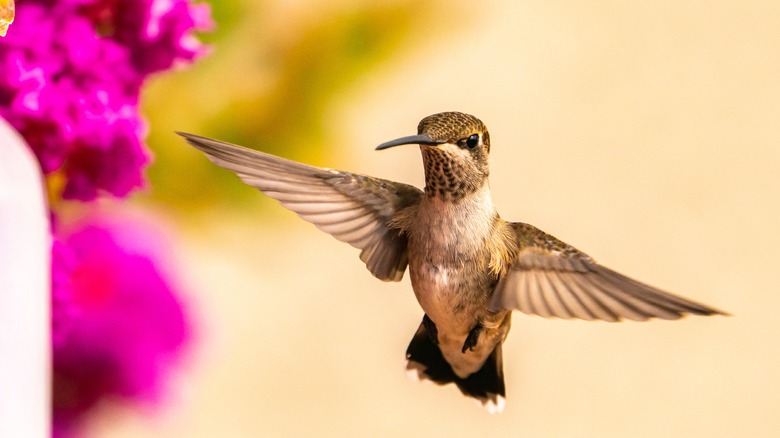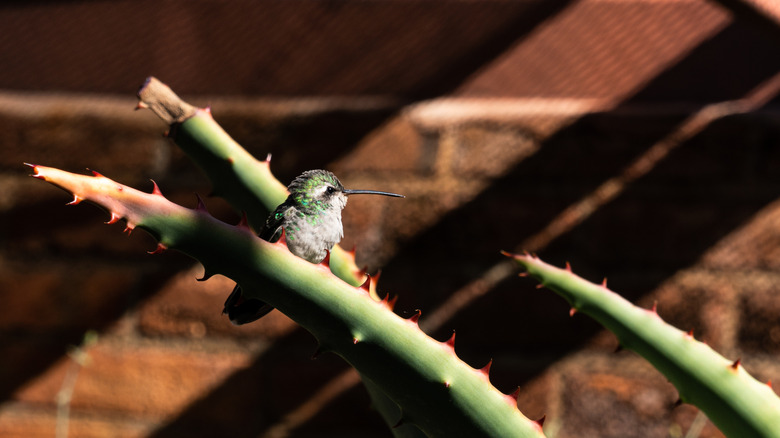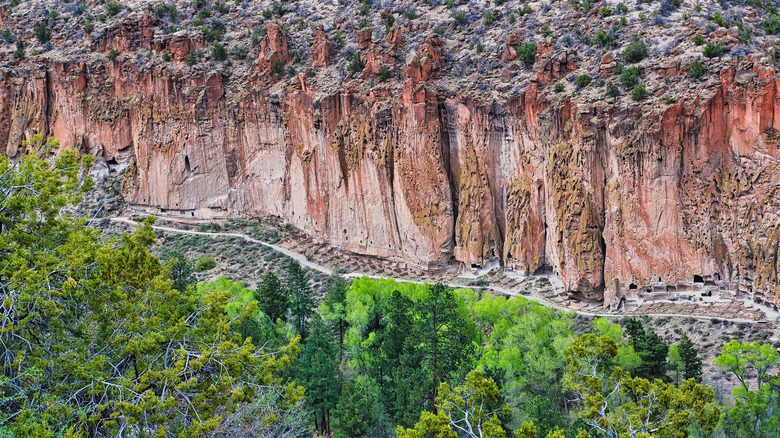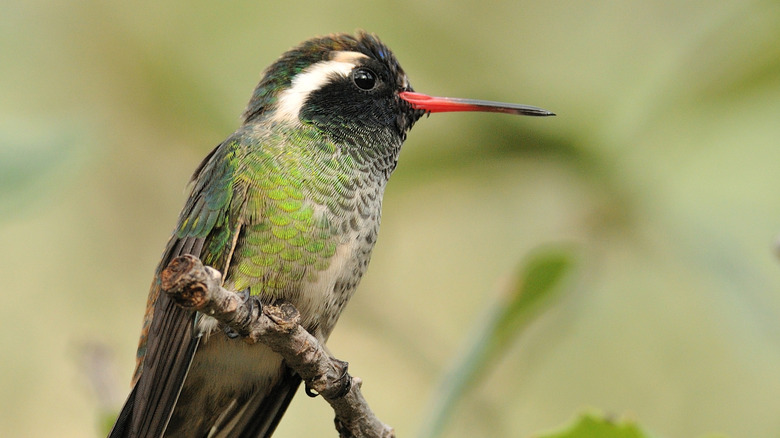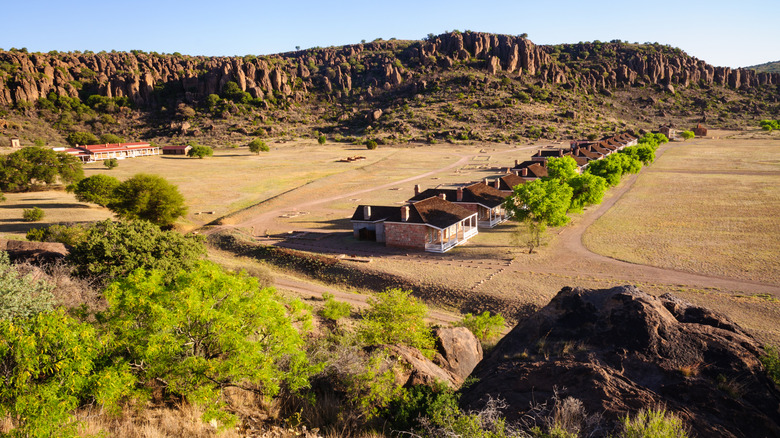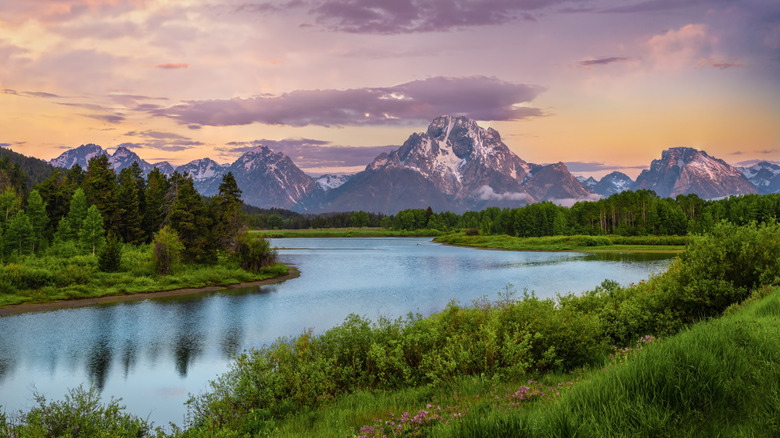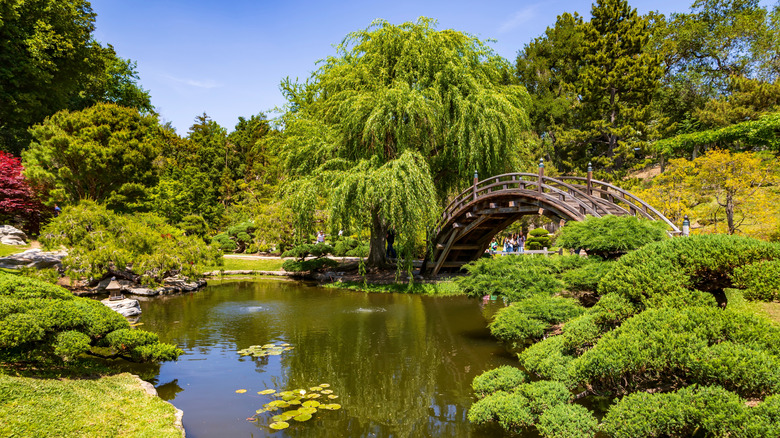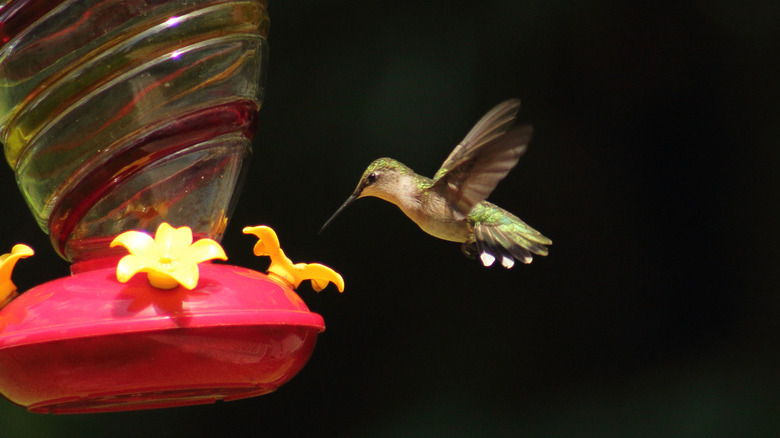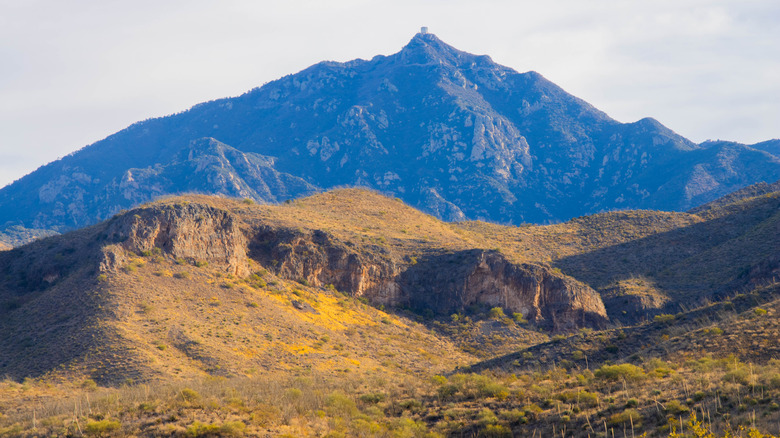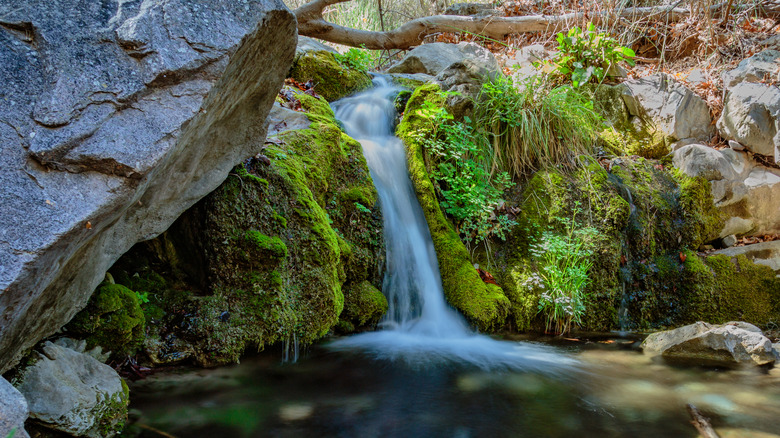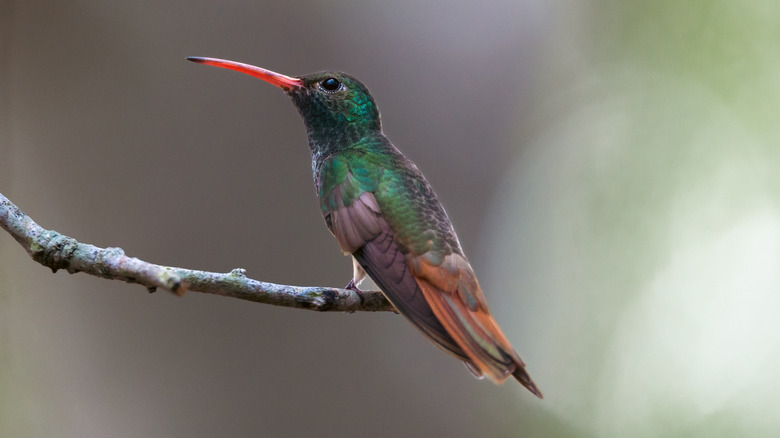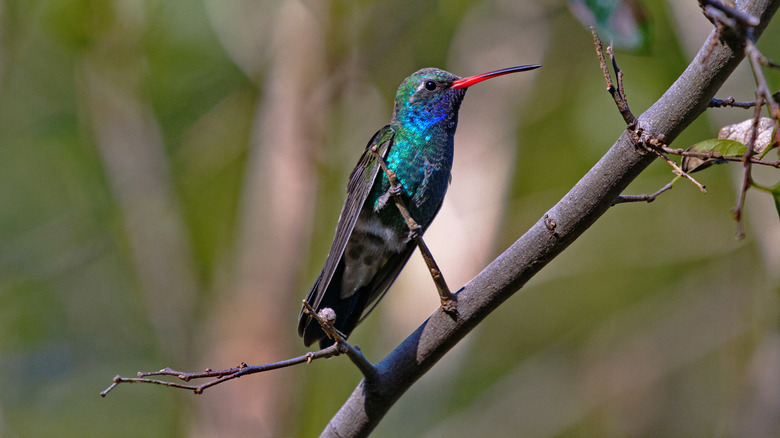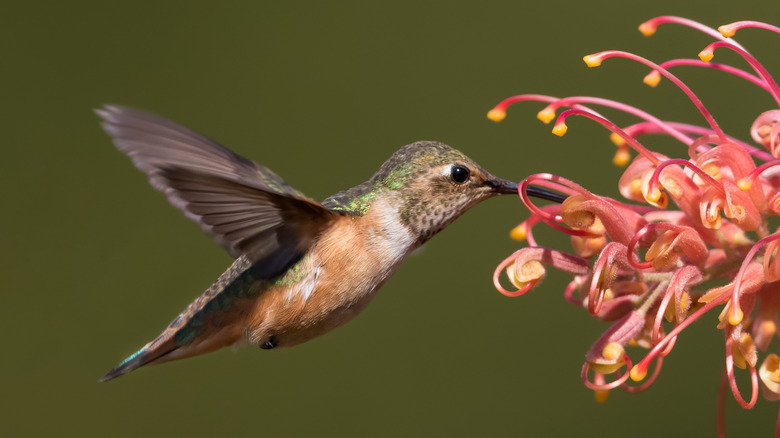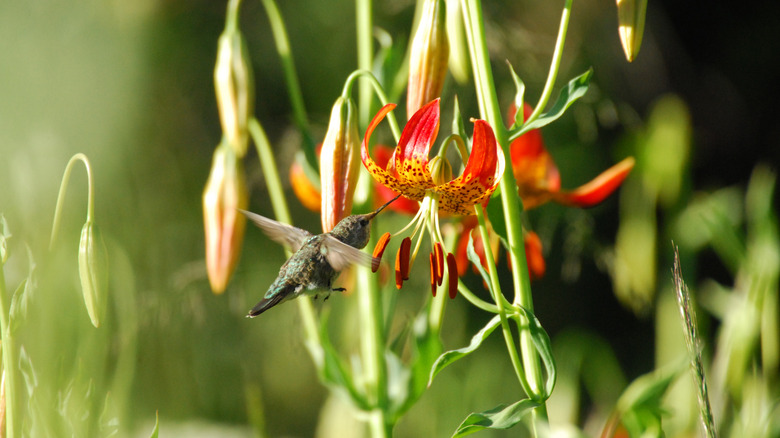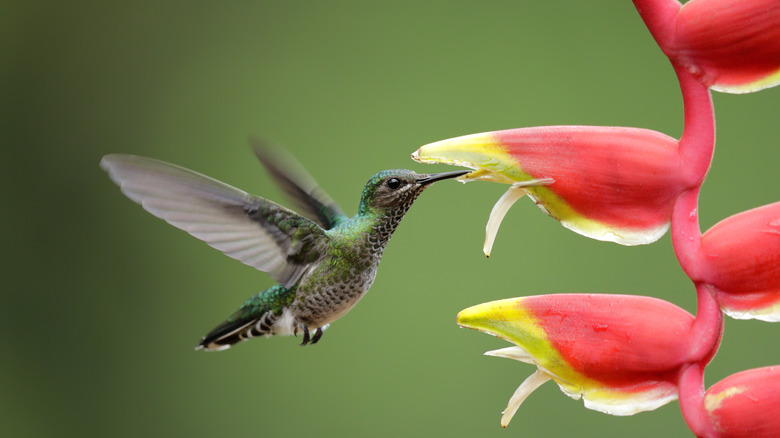The Most Beautiful Hummingbird Hotspots Across America, According To Research
What is it about the hummingbird that captures our imagination? The smallest of all bird species, hummingbirds are just a few inches in length and can weigh as little as a quarter teaspoon of sugar, though most of them weigh more than a penny (the average weight of a hummingbird lies somewhere between 0.1 and 0.2 ounces). While some casual observers might think that all hummingbirds are the same, there are more than 300 different types, although they are only found in the Western Hemisphere.
Even more remarkable are some of the bird's unique features and habits. They can flap their wings 70 times a second, or markedly faster when diving, and eat double their body weight in food every day since they have an incredibly fast metabolism. While the females generally have plain coloring to blend into the surroundings and easily protect their nests, males have bright feathers that shimmer in the light. And, unlike most other birds, they can hover. If you have ever seen a hummingbird, you will appreciate what sweet, powerful, graceful, and quick creatures they are.
Many hummingbirds migrate twice a year, moving between Central America and the U.S. in search of warm weather. However, some live in America year-round, mainly in the Western part of the country. So, if you want to see a hummingbird in the U.S. up close, you're in luck. We've looked at the birding site BirdForum and the avian-centric magazine Birds&Blooms to find the most beautiful places in the country where hummingbirds can be spotted.
Arizona-Sonora Desert Museum, Arizona
Located west of Tucson within Saguaro National Park West, this world-renowned botanical garden has much to offer. Visitors can watch red-tailed hawks flying free in the Sonoran Desert during regular demonstrations, touch live cownose rays in a large shaded pool, and see a woodland habitat where Mexican wolves roam. Another lure is the dedicated hummingbird aviary, set within an area known as the Pollination Gardens. Inside the building, tiny hummingbirds hover, fly, and flit from plant to plant. Visitors can get very close to the birds and maybe even feel the light movement of the air around them.
Among the species here are the Anna's, black-chinned, and broad-billed. Thanks to the controlled environment, there are frequent hatchings of newborn hummingbirds, and travelers that time their visit right will be able to see the nests and chicks. Visitors should also be sure to tour the museum's beautifully designed gardens that shine a light on desert flora and walk around the Desert Loop Trail for a chance to see lizards and javelinas.
Bandelier National Monument, New Mexico
In the warmer months of the year, bird enthusiasts stopping by Bandelier National Monument in New Mexico are in for a treat. That is when they have the opportunity to spot up to four species of hummingbirds at this site in Los Alamos. The black-chinned and broad-tailed hummingbirds are regular visitors to the park throughout the summer, the former easily identified thanks to its distinctive black head and straight, slender bill.
Later in the summer, the rufous hummingbird visits the park during its migration, while the calliope species is also seen on rare occasions. Visitors might also be lucky enough to see hummingbird nests made with lichens and moss and bound together by the delicate fibers of spiderwebs. Bandelier National Monument is an appealing destination in its own right, an area of wild canyons, petroglyphs, and remnants of ancient abodes with scenic trails through historic ruins spread across 33,000 acres of northern New Mexico.
Beatty's Guest Ranch, Arizona
For fans of the featherlight hummingbird, it doesn't get much better than this. Beatty's Guest Ranch sits at the edge of the Miller Peak Wilderness area, less than 20 miles from the border with Mexico. This is a consummately quiet spot, with the backdrop of the Huachuca Mountains adding to the sense of calm. The property features several simple cabins, some set at the base of a mountain, others tucked among trees or by a creek.
What really draws travelers here is the chance to see hummingbirds. The small creatures can be seen on trails, by the cabins, or from the bleachers, a popular spot where guests can find comfortable seating while setting up their photographic equipment. The ranch's grounds are home to a number of fruit trees, and their flowers and blooms are notable for attracting hummingbirds, as well as butterflies and bees, all drawn by the vast supply of pollen.
Cabrillo National Monument, California
Named for an explorer from the 16th century, Cabrillo National Monument rests at the end of the Point Loma Peninsula, a short drive from San Diego's international airport. Visitors can see a monument to Juan Rodriguez Cabrillo, wander the trails around the parkland, and spend time at the lighthouse on-site. On a clear day, views take in the endless Pacific and the border settlements of Mexico.
It isn't just humans that are attracted to this destination. Migratory birds often stop by this part of California, drawn by the variety of environments, from the jagged, rocky coast to the swathes of low-lying scrub. You might see American kestrels or California quails.
Another common sighting is Anna's hummingbird, which is attracted to the nectar found in wildflowers like those seen around the lighthouse. (If you can't resist California wildflowers, check out this guide on the best places to see them in the Golden State). Nature lovers might also want to stop by the tidepools, where an array of creatures can be found wading in the shallows.
Fort Davis National Historic Site, Texas
In Texas, travelers will find only a few areas known as sky islands. These unique geographical regions comprise cooler spaces that are typically prone to more rainfall than the flat desert plains that spread around them. The Davis Mountains are one of these sky islands, with ecosystems ranging from desert scrub to elevated forests with more temperate temperatures. It is there that visitors can find Fort Davis National Historic Site, a military garrison that helped to protect goods and people moving around this part of the Lone Star State. The spot will delight history buffs, but it is also a paradise for bird watchers.
More than 150 species of birds have been spotted at the site, including the black-chinned hummingbirds, which are most commonly seen in the summer. This is one of four types of hummingbird that visits Fort Davis, with Anna's and broad-tailed also appearing. Other birds not so common in Texas are also here year-round or during migration — look for the pygmy nuthatch and Woodhouse's scrub jay.
Grand Teton National Park, Wyoming
Once you learn what scarlet gilia and willow shrubs look like, lock the image in your head. These plants are what visitors should look for if they want to see calliope hummingbirds in Grand Teton National Park, which also happens to be the best national park for people who hate hiking. These tiny creatures — the smallest bird found on the continent — feast on the nectar of these plants and watching them feed is a heartwarming sight.
Of course, calliope hummingbirds aren't the only birds found in this vast area of wilderness. Trumpeter swans congregate at Flat Creek or Oxbow Bend. Near bodies of water, travelers might catch sight of ospreys or bald eagles, the former notable for how they transport their prey, slung on their talons. The park is also a great place to find the western tanager, a bird that seems like a compact bundle of gleaming sun thanks to its bright orange and yellow feathers.
The Huntington, California
In the Southern California city of Pasadena, the Huntington is an all-encompassing tourism destination featuring a library, gardens, artwork, and more. It traces its origins to 1919 when it was created as a medium for research and a way to engage the public through its various spaces. Among the lures are the finely landscaped gardens, spread across 130 acres and divided into more than 15 themes. It is within these expansive, colorful gardens that travelers will find hummingbirds. The garden crew at The Huntington has judiciously used certain plants to attract these tiny birds, and a healthy supply of water, nesting areas, and food ensures that the hummingbirds prosper in this part of California.
Costa's, Allen's, and Anna's hummingbirds are at the Huntington all year, while a few other species make a seasonal appearance. They can be seen feasting on the nectar in the autumn sage massed in bushes by the Huntington Art Gallery or grevillea by the Visitor Center and Australian Garden. While visiting the Huntington, travelers should explore all the gardens, from the Chinese Garden to the Camellia Garden and even a romantic space filled with roses.
Lake Hope State Park, Ohio
Naturalists hand-feed hummingbirds at this park in the summer, and for onlookers lucky enough to witness it, this is an unforgettable sight. Lake Hope State Park is a realm of water and woods, a forest in the middle of Ohio where hiking trails trace lines across the terrain. Visitors will come across tight ridges, towering gorges, and a profusion of oak and hickory trees among the abandoned iron mines. This is where wild turkeys roam and deer hide among the dense foliage.
There are also many wildflowers that bloom seasonally, from the blue-eyed Mary to the yellow lady's slipper. But it's not just these ephemeral blooms that lure the hummingbirds. On select days at the park's nature center each summer, a presentation on the finer points of hummingbirds precedes park staff hand-feeding these winged wonders. You'll get to see ruby-throated hummingbirds sipping nectar from a slender feeder tube, and some visitors to the park will even be able to feed the birds themselves.
Madera Canyon, Arizona
South of Tucson (a UNESCO city of culinary excellence), this area is home to 15 species of hummingbird. Thanks to its elevation and shaded canyons, Madera Canyon is a good place for hiking in slightly cooler weather, escaping the heat that can grip Tucson for months on end. Madera Canyon is one of Arizona's sky islands, thanks to woods and ravines on the northern side of the Santa Rita mountains. The canyon offers many miles of hiking trails, some flat and easy, others that will work the quads of even seasoned hikers.
Birders also flock to the canyon, with more than 250 species of birds found here. From June to September, hummingbirds buzz and flutter around the canyon, and among the most visible are Costa's hummingbird, whose adult males have rich purple patches around the head. Madera Canyon is also home to elegant trogons, a prized spot among the birding crowd in the U.S.
Ramsey Canyon Preserve, Arizona
A short distance from Beatty's Guest Ranch, this rich, diverse ecosystem supports hummingbirds, bats, and snakes. The preserve sits within a sky island, where the Huachuca mountains climb above dry grassy plains, creating interesting, diverse microclimates. Ramsey Canyon Preserve benefits from these unique conditions, and the climate allows the preserve to maintain flora such as Chihuahua pine trees, animals such as the lesser long-nosed bat or the elegant trogon, and also Anna's and Rivoli's hummingbirds. Streams that are constantly replenished by springs and sheer canyons allow moisture to be trapped within the preserve.
Visitors find maple and sycamore trees in the area, while agaves and cacti thrive nearby. The sight is both perplexing and thrilling. In most years, travelers might see 12 species of hummingbird, though 15 have been spotted in the canyon through the decades. April to early September is the best time for viewing, though the beginning and tail-end of that window are truly optimal. Expect to see white-eared, berylline, Rivoli's, and violet-crowned hummingbirds.
Rio Grande Valley, Texas
The vast Rio Grande Valley separates the U.S. and Mexico, a 5,000-square-mile slice of land that contains hundreds of cities and towns. Grand populations live and work in the valley, but it is also a reliable spot to see the buff-bellied hummingbird. This species is wonderfully colorful, with a red bill and feathers that glimmer with an almost iridescent green. They differ somewhat as their bellies are a little more rounded than other hummingbirds (hence the name).
The buff-bellied hummingbirds exist in abundance along the Rio Grande Valley, on the river, in low-lying brush, and often in the gardens of homes where they slurp nectar from flowers. Houses in the area appreciate the presence of these tiny treasures, and many keep hummingbird feeders and nectar-rich plants in their gardens to attract the birds. Parks around the valley also keep feeders on hand so the public can easily see these delightful creatures.
Tohono Chul, Arizona
Within almost 50 acres of desert landscape, Tohono Chul is a garden that presents some of the highlights of the local natural environment. The spot definitely has a sense of place, and travelers can wander among large Saguaro cacti, amble through botanical displays, and look for hummingbirds that live there year-round. The Anna's and Costa's species can be found in the gardens in all seasons, drawn by the bright flowers dotted around the grounds.
During spring and summer, they are joined by black-chinned, rufous, and calliope hummingbirds, seasonal visitors attracted by the rich trove of food sources. Hummingbirds aren't the only birds that frequent these gardens. Cooper's hawks call the landscape home, while phainopepla, with their almost comical tuft of feathers atop the head and bright red eyes, appear during the cooler months. After a walk in the wilds, visitors can enjoy some delicious Southwestern fare at the on-site restaurant.
Tucson Audubon's Paton Center for Hummingbirds, Arizona
The name of this establishment says it all, and it is a place that celebrates this tiny bird as its main mission. However, Tucson Audubon's Paton Center for Hummingbirds also honors the natural environment of the region. The preserve, located in Patagonia near Nogales and the Mexican border, features a shaded area where visitors can comfortably sit and gaze at hummingbirds sipping from bird feeders. The violet-crowned hummingbird — with a crown of purple feathers atop its head — is among the main attractions. The center is an ornithologist's paradise, with more than 250 species spotted around the grounds.
In addition to the tiny winged wonders, visitors will be able to see green-tailed towhees and gray hawks. More winged creatures flutter around the Richard Grand Memorial Meadow at the center as the flowers attract butterflies. And at the main pond, visitors might spot the Gila topminnow, an endangered fish. Entry to the center is always free, and it is open during the hours of light each day. For travelers who can't make it there in person, a live webcam lets armchair birders watch the hummers from the comfort of home.
University of California Santa Cruz, Arboretum & Garden, California
If you want to see hummingbirds in generous numbers, come to this destination south of San Francisco. Specifically, you should visit in March (known as Hummingbird Month) when Anna's and Allen's hummingbirds are the star attractions. According to Bruce Lyon, a professor at the university, the concentration of the hummers during that time of year is "ridiculously high" (via the university's website). The birds flutter and hover around flowers, sipping on the nectar using their long, slender bills. Males chase females as part of courtship rituals, and the spectacle is as fascinating as it is beautiful.
The birds are especially drawn by the Australia and South Africa gardens, where the blooms provide nutrients year-round. During March, visitors can take guided walks or listen to lectures about these tiny birds. Tourists visiting in summer can join bird tours that wind through the gardens. Elsewhere on the university campus, travelers will be able to see hawks, kites, harriers, and quails around the woods and grassy areas of the complex.
Yosemite National Park, California
This park — home to one of the world's most iconic natural wonders — is home to many different species of hummingbirds. Among them is Anna's hummingbird, which pollinates plants throughout the park and draws nectar in the process. That species lives in Yosemite all year, but visitors will also be able to see the calliope hummingbird (the smallest of all types of hummingbird) during the summer.
Some people mistake adult calliope hummingbirds for babies due to their Lilliputian dimensions, as they weigh a fraction of an ounce and are considered the smallest birds on the continent. Travelers should look for these tiny beauties in May and June, and they are often seen in the canyons among the alder and willow trees, sipping nectar from wild currant blooms. Other seasonal guests are the black-chinned and rufous varieties, the latter known for males with fiery orange feathers.
Methodology
Only found in the Americas, hummingbirds are truly unique birds. Their movements are almost like a hybrid between birds and bees, with the ability to swoop, dive, and hover. To see one is an unforgettable experience, so locating a site where you can reliably find one is not to be underestimated. We compiled this list of the most beautiful hotspots to see hummingbirds in America by consulting websites and forums specifically geared toward bird enthusiasts.
BirdForum is an excellent resource for first-hand information from birders, while Birds&Blooms focuses on readers who have an interest in birding and gardens. We also consulted Hummingbird Central, a site that seeks to promote interest in and understanding of these birds. When finalizing our choices, we picked places that ranged from grand wilderness to carefully landscaped gardens and nature centers. We also chose spots where the opportunity to see hummingbirds is reliable and relatively easy to predict.
